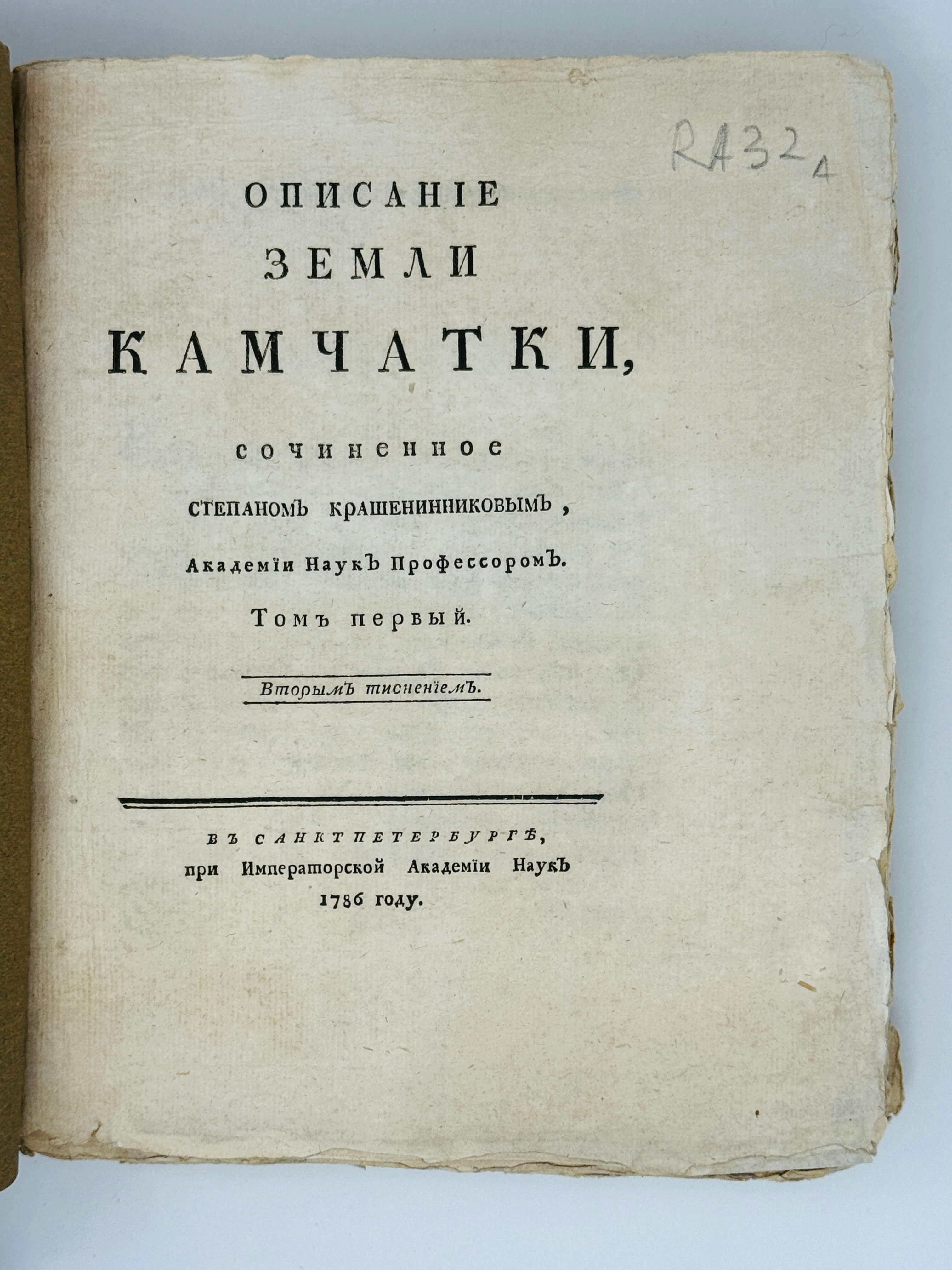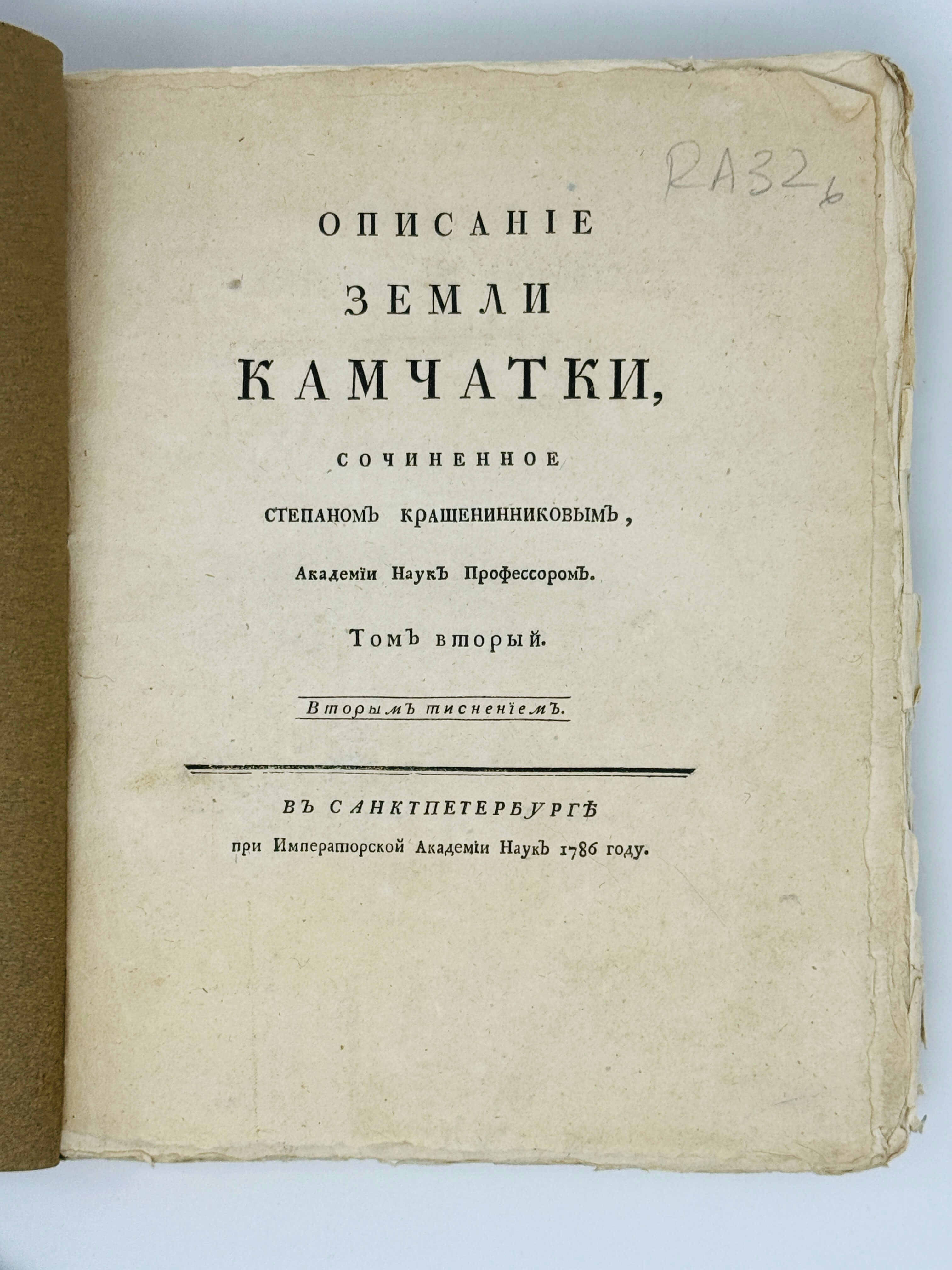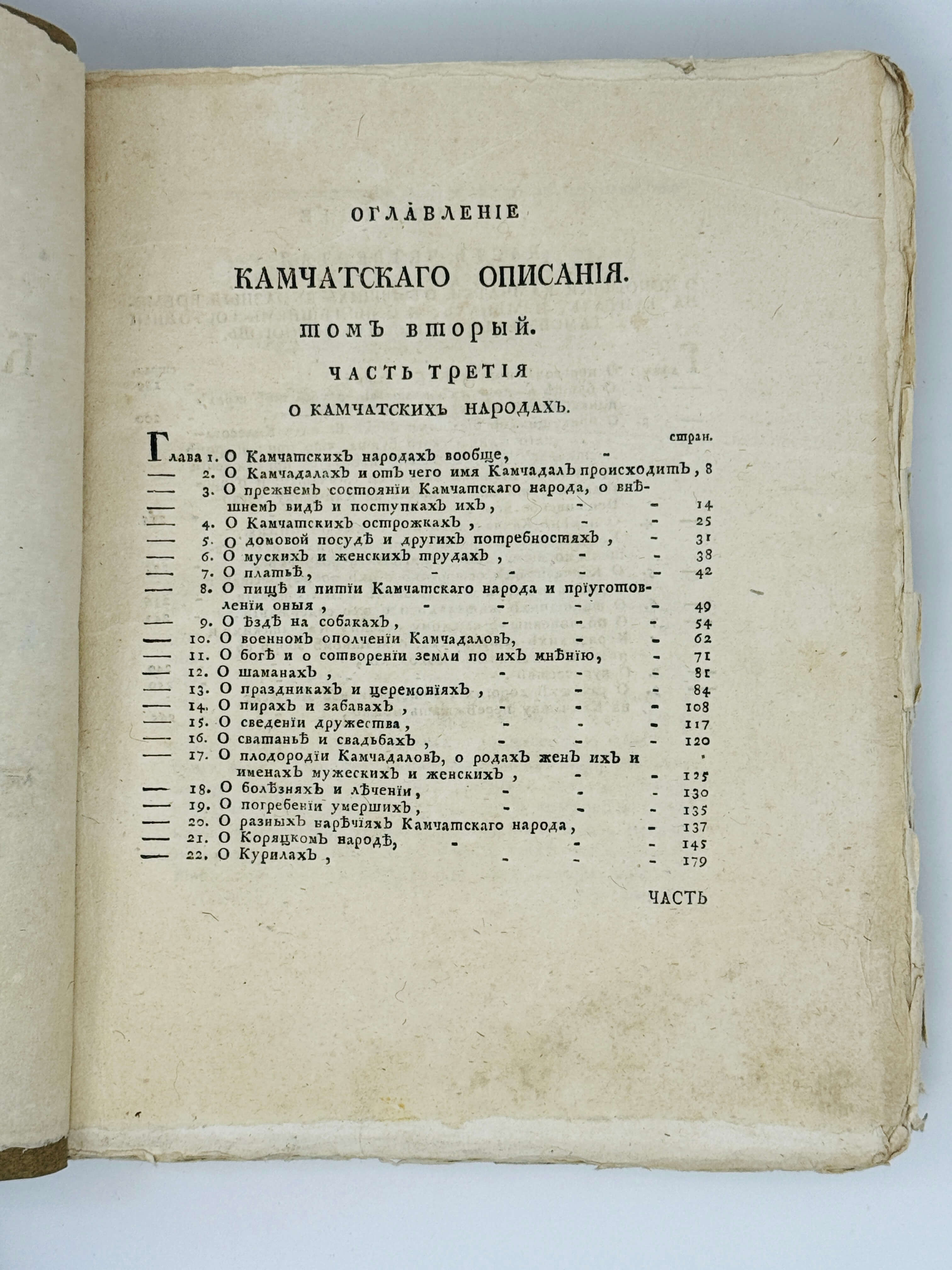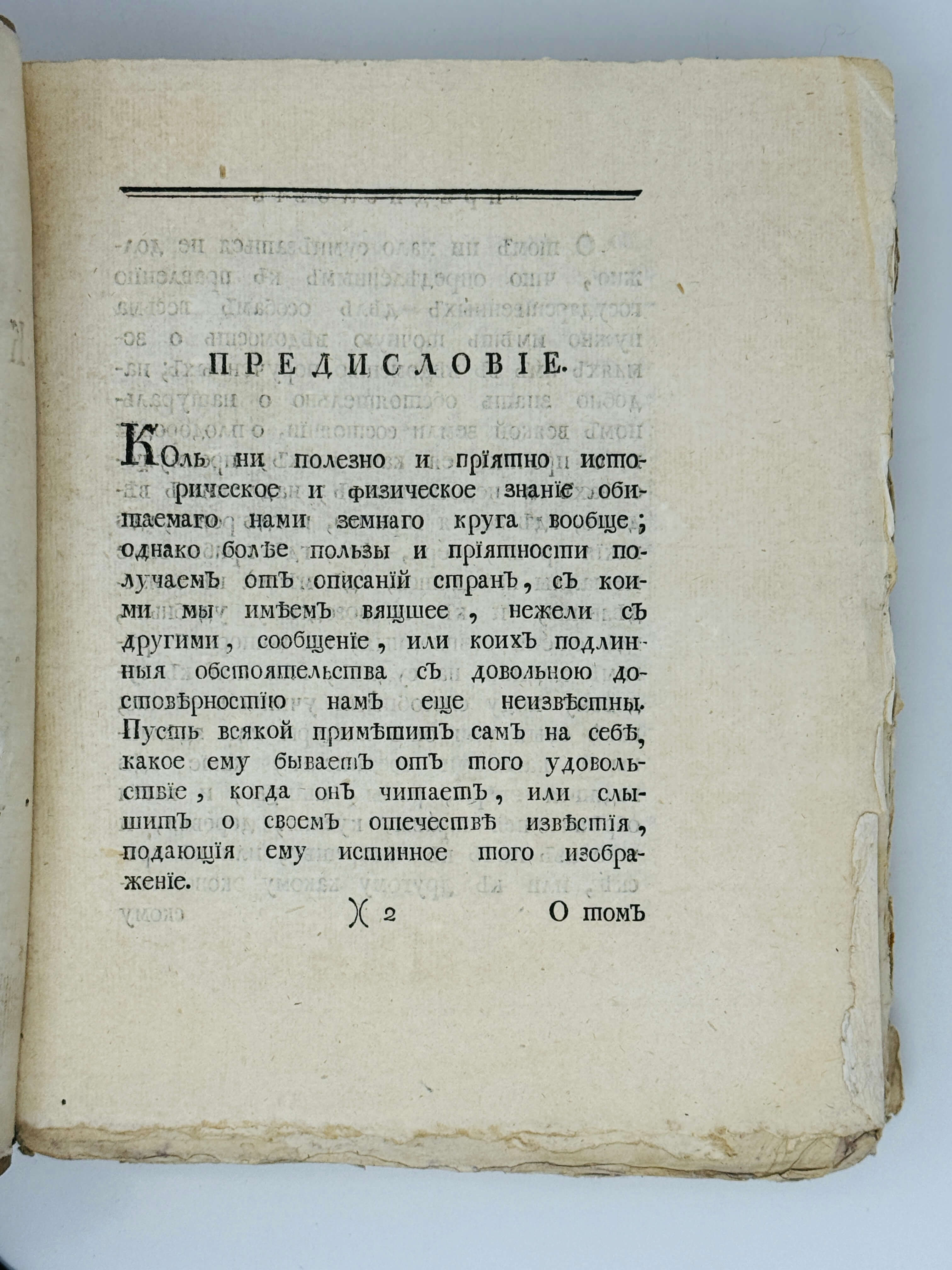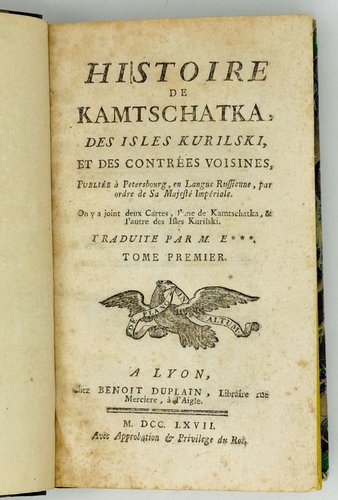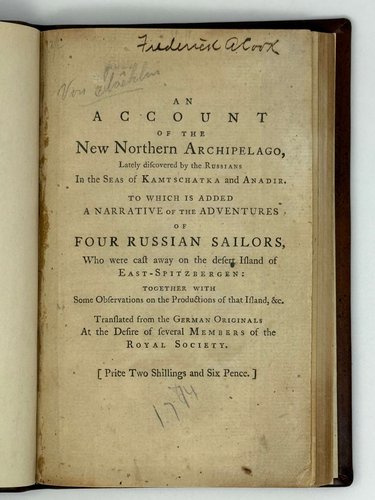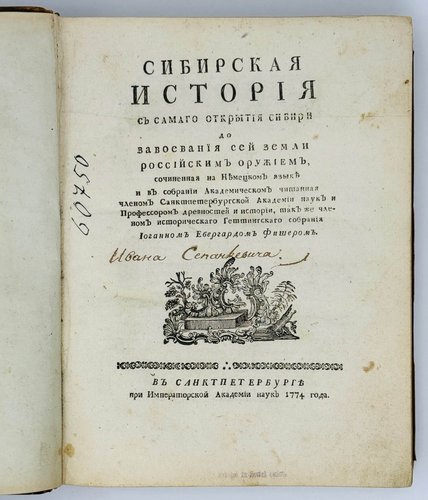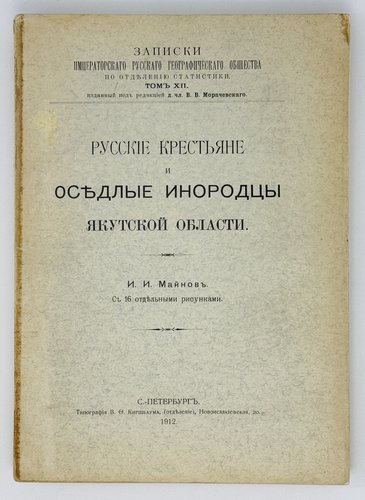
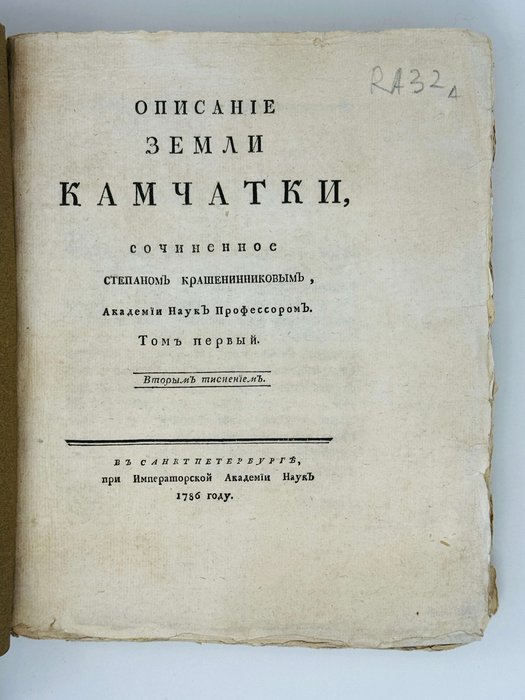
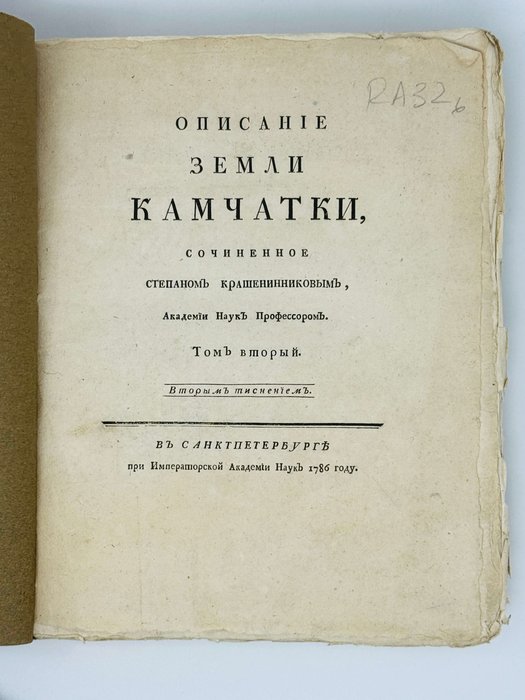


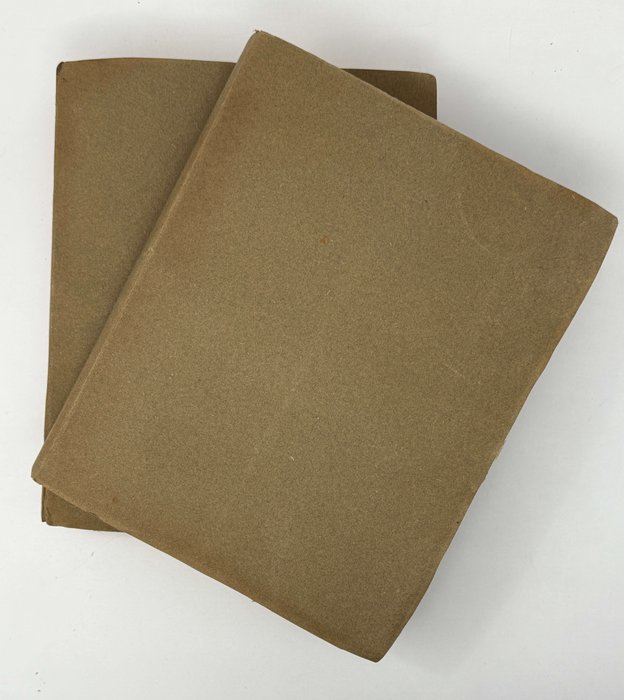
#RA32
1786
Second edition without changes. Quarto (ca. 26,5x21 cm). [1 – t.p.], [16 - preface], [2 – table of contents], 438; [2 – t.p.], [2 – table of contents], 319 pp. Text only, published without illustrations. Two ink stamps of a Soviet bookshop on the last page of vol. 1. Later brownish laid paper wrappers. Several leaves in vol. 2 with occasional water stains on the margins, but overall a very good untrimmed copy of this rare set.
Very rare Russian imprint with only three paper copies found in Worldcat (Harvard University, Stanford University, National Museum of Natural History, Paris). The first Russian scientific monograph on Kamchatka and the eastern frontiers of the Russian Empire (including Alaska and the Aleutian Islands), as well as the first Russian ethnographic work on the people of the region (Itelmens, Koryaks, Aleuts, Ainu). “One of the earliest printed narratives about Alaska and the Aleutian Islands. The engraving of an “American,” facing p. 128, is the earliest pictorial representation of a native inhabitant of any part of Alaska” (Lada-Mocarski, 12).
The book presents the results of Krasheninnikov’s travels in Kamchatka in 1737-1741 in the course of Vitus Bering’s Great Northern Expedition (1733-1743). It has become a classical Russian travel account, written and published before the famous European and Russian circumnavigations and exploratory voyages of James Cook, Jean-Francois de Laperouse, Gavrila Sarychev, Adam von Krusenstern, and many others. A student attached to the “Academic Department” of Bering’s expedition (professors Johann Georg Gmelin, Gerhard Friedrich Müller and Louis de l'Isle de la Croyère), Krasheninnikov spent three years in Siberia (1733-1736) and then was sent to Kamchatka, where he worked for four years. He extensively travelled across the peninsula, having crossed it several times, and compiled the first detailed description of its geography, relief, flora, fauna, and native people, together with the history of its conquest and settlement by the Russians. Preparing his materials for publications, Krasheninnikov was assigned to use the journals of Georg Steller (1709-1746), who took part in Bering’s famous exploratory voyage to Alaska from June 1741 – July 1742. Chapter 10,“About America” (vol. 1, part 1), is the first publication of Steller’s observations (as Krasheninnikov carefully noted).
The first edition was published in 1755 by the Imperial Academy of Sciences in Saint Petersburg. This, second edition was issued thirty years later by the same typography, practically without changes, with a print run of 912 copies (Svodny Katalog 3291). This edition is more rare than the first one, which was printed in 1350 copies (Svodny Katalog 3290) and is available in ten copies in Worldcat (Library of Congress – incomplete, University of Alaska Fairbanks, University of Minnesota – Twin Cities, University of Michigan, American Museum of Natural History, British Library, University of Cambridge, Deutsche National Bibliothek, Göttingen University, National Diet Library - Japan).
The main difference with the first edition is the placement of the preface, written by the book’s editor Gerhard Friedrich Müller (1705-1783, a member of the Great Northern Expedition and an influential German historian and ethnographer in Russian service) – in vol. 2 of the first edition vs. vol. 1 of the second edition. The second edition also doesn’t contain a short “Notice to the reader,” placed after the title of vol. 1 of the first edition – evidently, it wasn’t considered necessary, being replaced by a more substantial preface. At the same time, not all copies of the first edition were issued with the preface, as noted by Lada-Mocarski (p. 60). The second edition also has simple capital letters replacing woodcut initials at the beginning of each of the four parts of the book.
The book consists of two volumes, each in two parts. The first part of vol. 1 is a description of the geography of Kamchatka and the “adjacent lands.” Chapter 10 of the same part (vol. 1) titled “On America and some islands laying between America and Kamchatka” (pp. 121-139) describes the Alaskan coast in the vicinity of Mount Saint Elias, visited by Bering and Steller in July of 1741, and Bering Island. Having based on Steller’s observations, Krasheninnikov wrote about the Alaskan coastline, climate, relief, the “American Sea” separating Alaska and Kamchatka, noted that the climate in America was “better,” soil was more fertile and shores had more forest than in Asia; described American flora and fauna, and native Americans (pointed on their possibly Asian origin, resemblance to Koryaks and Chukchi, and talked about their costumes, boats, weapon, language, and greeting speech when approaching strangers).
The second part of vol. 2, titled “About advantages and disadvantages of Kamchatka Land,” focuses on local geology and volcanism, hot springs, ores and mineral deposits, flora and fauna, fur hunt, and tides in the Penzhinskoye Sea (Shelikhov Gulf in the Sea of Okhotsk) and Eastern (Pacific) Ocean. The last chapter contains six tide tables: in the Bolshaya River in 1739 and 1740 (pp. 354-371, 372-390), Penzhinskoye Sea in 1738 (pp. 391-393), Okhotsky Ostrog [fort] in 1739 (pp. 394-396), Petropavlovsk in 1741 (pp. 397-398), and one of the Kurile islands in 1742 (p. 399).
The first part of vol. 2 is the first comprehensive ethnographic description of the people of Kamchatka and the Kurile Islands. The main text is supplemented with three dictionaries of the most common words and phrases in the: 1) dialects of three Kamchadal (Itelmen) groups (pp. 138-144); 2) four Koryak tribes (pp. 169-178); 3) and Kuriltsy (Ainu) people from the Kurile islands (pp. 185-188). There are also lists of the most common Itelmen (p. 128), Koryak (pp. 165-166) and Ainu (p. 184) male and female names. Very interesting is the text of the Lord’s Prayer in the language of southern Itelmens, modified to be understandable by them (taken from Georg Steller’s notes, see p. 145). Pp. 114-115 of vol. 2 contain musical chords and text of a native song, talking about “Lt.-Col. Merlin, Mayor Pavlutsky and Student Krasheninnikov.”
The second part of vol. 2 is a historical overview of the Russian conquest and settlement of Kamchatka. The part contains lists of over seventy Russian ostrogs/forts, including the numbers of their inhabitants and specialized hunters for sables, foxes, and beavers. There is also a list of prices for the most common goods in Kamchatka (pp. 263-264). Each volume concludes with an extensive alphabetical index compiled by one of the first Russian bibliographers, Andrey Bogdanov (1692-1766).
Our copy is integral and contains text only, without traces of copper-engraved illustration being removed. Likely, this was a separately printed copy of the text, perhaps a remaindered copy, and the maps and plates were intended to be bound in a separate volume.
“Krasheninnikov, a young student of the Academy of Sciences, was sent to join Bering’s second expedition as an assistant to Steller. Steller and he spent some time exploring Kamchatka and making notes for a subsequent report. Steller’s notes were available to Krasheninnikov, who used them in the preparation of the present work, along with his own observations. In the preface which Krasheninnikov proposed to write for his work, he was to give information as to how he happened to be sent to Kamchatka, also what part of Steller’s work was included by him in his Description, etc. Unfortunately, Krasheninnikov died before the printing of his Description was completed. In the text of the latter, however, Krasheninnikov often mentioned Steller as the source of his information. Furthermore, since Krasheninnikov did not go to sea with Bering while Steller did, Chapter 10 of vol. 1, entitled “Regarding America,” was compiled by our author from the notes made by Steller. This chapter gives a great deal of information and is one of the earliest printed narratives about Alaska and the Aleutian Islands. The engraving of an “American,” facing p. 128, is the earliest pictorial representation of a native inhabitant of any part of Alaska <…> it is a very rare book (first edition) and difficult to secure…” (Lada-Mocarski, 12).
"The Russian Krasheninnikov started out across Siberia with Gerhard Friedrich Mueller and Johann Georg Gmelin, and then made his own way to Kamchatka. When Georg Wilhelm Steller arrived in Kamchatka to supervise his work, Krasheninnikov left in order to avoid becoming Steller's assistant,and returned to St. Petersburg. Krasheninnikov nonetheless was able to make use of Steller's notes in the preparation of his own narrative, and the inclusion of Steller's observations on America, made during his travels with Bering's second voyage, are an important part of this work, and constitute one of the earliest accounts of Alaska and the Aleutian Islands. Steller's account was not published until 1793. This work details the customs, morals, and religion of the Kamchatka peninsula, and discusses the power exercised by the magicians. Also described are the differences between the dialects of the Kamchatkans and those of the Koryaks and of the Kurile islanders. This is the first scientific account of those regions" (Hill 948-9).
"Krasheninnikov journeyed through Siberia (1733-36) and the Kamchatka Peninsula (1737-41) before giving the first full description of the latter. Krasheninnikov volcano (6089 feet) is named after him" (Sotheby's); Cox I, p.351; Howgego K37; Sabin 38303.
Svodny Katalog (“[General Catalogue of Russian Books of the 18th century, 1725-1800],” M., 1962-1967, 5 vols.) 3291, Sopikov 7568, Bitovt 2138, Guberti 71, Obolyaninov 1380.

